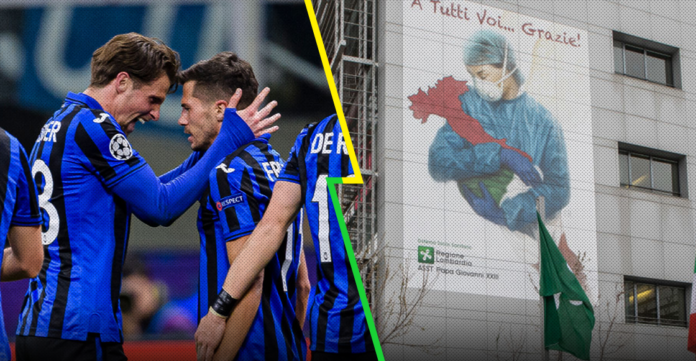NEW YORK (VINnews) — On the 19th of February, just days before the first case of COVID-19 was diagnosed in Italy, a soccer game took place in Milan between local Italian team Atalanta and Spanish team Valencia in the framework of the European Champion’s league. The game was held in Milan’s huge San Siro stadium because Atalanta’s stadium in the town of Bergamo didn’t meet European standards. 40,000 fans flocked to see the small town’s team take on one of Europe’s giants.
Join our WhatsApp groupSubscribe to our Daily Roundup Email
Now, more than a month later, experts are pointing at this game as one of the biggest reasons why Bergamo, Italy, has become one of the epicenters of the coronavirus pandemic — a “biological bomb” was the way one respiratory specialist put it. An innocent soccer game may have infected hundreds of thousands both in Italy and in Spain and caused untold misery in both countries.
“We were mid-February, so we didn’t have the circumstances of what was happening,” Bergamo mayor Giorgio Gori told The New York Post this week. “If it’s true what they’re saying that the virus was already circulating in Europe in January, then it’s very probable that 40,000 Bergamo residents (Bergamaschi) in the stands of San Siro, all together, exchanged the virus between them. As is possible that so many Bergamaschi that night got together in houses, bars to watch the match and did the same.
“Unfortunately, we couldn’t have known. No one knew the virus was already here. It was inevitable.”
The match was the first leg of a home-and-away set in the Champions League’s Round of 16. Atalanta won, 4-1. The official attendance for the Feb. 19 game was 45,792 — a “home” record for Atalanta, which is making its debut in Europe’s top club competition.
It was the biggest game in Atalanta’s history and a third of Bergamo’s population — including nearly 30 busloads of fans — made the 37-mile trip from Bergamo to Milan.
“It’s a city of 120,000 people and that day 40,000 went to the San Siro,” Atalanta captain Alejandro “Papu” Gómez told Argentine daily Olé. “It was a historic match for Atalanta, something unique. To give you an idea, my wife took three hours to get to Milan, when that trip normally takes 40 minutes.”
Nearly 2,500 fans of visiting Valencia also traveled to the match.
The conditions for virus contagion were high, with thousands of people gathering without much concern — at a time when the outbreak in Europe wasn’t yet known — and then traveling back home.
Before the match, Valencia fans freely roamed around Milan and gathered at some of the city’s plazas, including the Piazza del Duomo, drinking and chanting team songs.
“I have heard a lot of theories, I’ll say mine: Feb. 19, 40,000 Bergamaschi went to San Siro for Atalanta-Valencia,” Fabiano di Marco, the chief pneumologist at the hospital in Bergamo, told Italian newspaper Corriere della Sera. “In buses, cars, trains. A biological bomb, unfortunately.”
Not just fans but players were also infected by the contagious virus. Atalanta announced its first positive case Tuesday for goalkeeper Marco Sportiello, while Valencia said that more than a third of its squad got infected, “despite the strict measures adopted by the club” after the match in Milan. Valencia defender Ezequiel Garay was the first Spanish league player to test positive for COVID-19.
Valencia played a Spanish league game against Alavés about two weeks after the game in Milan, and later Alavés reported that 15 people in the club were infected, though it did not say the cases were directly related to the match against Valencia.
A journalist who traveled to the match from Valencia became the second person infected in the region, and it didn’t take long before people who were in contact with him also had the virus, as did Valencia fans who were at the game.
Over the past month, Atalanta has mourned the deaths of five former staff members. While announcements on the club website made no mention of the virus, local media have reported that at least four of them died with COVID-19.
Less than a week after the Atalanta-Valencia game, the first cases were reported in the province of Bergamo.
As of Tuesday, nearly 7,000 people in the province of Bergamo had tested positive for COVID-19 and more than 1,000 people had died from the virus — making Bergamo the most deadly province in all of Italy for the pandemic.
“I’m sure that 40,000 people hugging and kissing each other while standing a centimeter apart — four times, because Atalanta scored four goals (the final result was 4-1) — was definitely a huge accelerator for contagion,” said Luca Lorini, the head of the intensive care unit at the Pope John XXIII hospital in Bergamo.
“Right now we’re at war. When peace time comes, I can assure you we will go and see how many of the 40,000 people who went to the game became infected,” Lorini added. “Right now we have other priorities.”
By last week, Bergamo’s cemetery became so overwhelmed by the number of dead that military trucks began transporting bodies to a neighboring region for cremation. Meanwhile, Spain remains the second-worst-hit country in Europe after Italy, with more than 6000 coronavirus casualties as of March 29.

